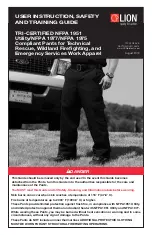
6
SCBA
– Acronym for Self-Contained
Breathing Apparatus.
Sewn Seam
– A series of stitches joining
two or more separate pieces of material(s) of
planar structure, such as textile fabrics.
Stabilization
– Those activities directed
at mitigating the dangerous elements of an
emergency incident.
Structural Firefighting
– The activities
of rescue, fire suppression, and property
conservation in buildings, enclosed
structures, vehicles, marine vessels, or
like properties that are involved in a fire or
emergency situation. NFPA 1951 Utility/
NFPA 1977/NFPA 1975 Tri-Certified Pants are
NEVER to be used in proximity firefighting and
do not provide the required level of protection.
Technical Rescue Incidents
– Complex
rescue incidents requiring specially trained
personnel and special equipment to complete
the mission.
Technical Rescue Operations
– Those
activities directed at locating endangered
persons, removing endangered persons from
danger, treating the injured at an emergency
incident, and providing transport to an
appropriate health care facility.
TPP
– Acronym for Thermal Protective
Performance. A test in NFPA 1951
Utility Standards to determine the ability
of a Pants composite to protect against
a measured amount of thermal and
radiant heat.
Trench/Cave-In Rescue
– The activity of
rescue during the collapse or cave-in of a
trench. A trench is deeper than it is wide.
Useful Life
– The period of time that NFPA
1951 Utility/NFPA 1977/NFPA 1975
Tri-Certified Pants, which have been
properly cared for, can be expected to
provide reasonable limited protection.
Useful life of Pants is normally 4 years,
depending on the materials making up the
Pants and moisture barrier in a multi-layer
garment, or the trilaminate material used in
a single-layer garment, and the conditions of
wear, maintenance and storage. Useful life is
highly unlikely to be more than 7 years. See
Section 14 of this Guide.
Wildland Firefighting Protective Pants
-
The coat, trouser, or coverall of the certified
Wildland Firefighting protective ensemble that
provides protection to the upper and lower
torso, arms, and legs.
Utility Technical Rescue Protective
Ensemble
– Multiple elements of protective
clothing and protective equipment designed
and configured as an ensemble to provide
limited protection in operational settings
where exposure to physical and thermal
hazards are expected.
Utility Technical Rescue Protective Pants
Element
– The coat, trouser, or coverall of
the certified utility technical rescue protective
ensemble that provides protection to the
upper and lower torso, arms, and legs.
UV (Light or Radiation)
– Acronym
for Ultraviolet Light. A type of radiated
electromagnetic energy commonly found in
the sun’s rays.
Vehicle/Machinery Functional
Capability
– The activity of removing a
victim from a vehicle or machine at an
emergency incident.
Содержание NFPA 1975
Страница 22: ...22 NOTES...





















